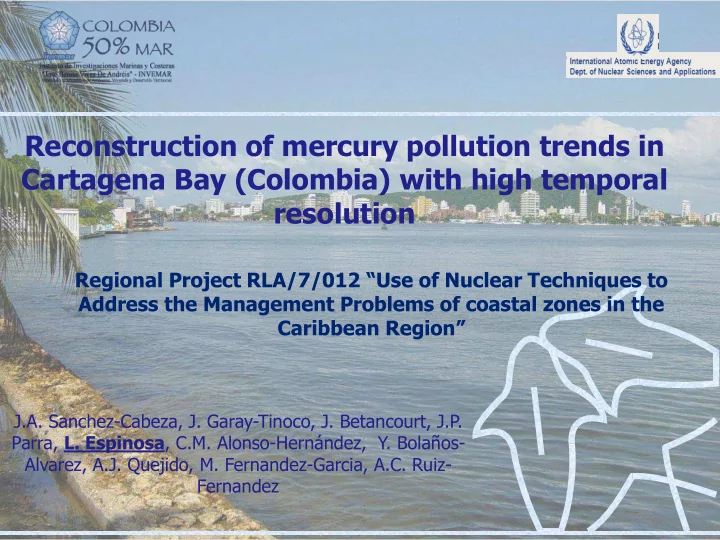

Reconstruction of mercury pollution trends in Cartagena Bay (Colombia) with high temporal resolution Regional Project RLA/7/012 “Use of Nuclear Techniques to Address the Management Problems of coastal zones in the Caribbean Region” J.A. Sanchez-Cabeza, J. Garay-Tinoco, J. Betancourt, J.P. Parra, L. Espinosa , C.M. Alonso-Hernández, Y. Bolaños- Alvarez, A.J. Quejido, M. Fernandez-Garcia, A.C. Ruiz- Fernandez
Introduction latitude: 10º26 ’ - 10º16 ’ N longitude: 75º30 ’ - 75º36 ’ W Bocagrande Bocachica Depth 16 m to 26 m. Dimensions: 14.4 x 6.4 km Surface: 82 km 2
Introduction Cartagena is an area of great interest to Colombia, as many activities are present: • Tourism • Artisanal fisheries • Industries • Port services
Introduction The Dique Canal is in the southern part of the bay. It discharges 100-1000 m 3 /sec of fresh water to the bay, giving the water body the characteristics of an estuary. Cartagena Bay receives approximately 80,000 m 3 /sec of urban wastewater from the city which has a current population of 1.000.000 inhabitants.
Introduction Cartagena Bay is one of the most studied water bodies in Colombia. Studies on heavy metal pollution began in the late 1970s when mercury (Hg) pollution became evident in the bay due to the operation of a Chlor- Alkali plant which discharged Hg residues to the sea. Studies show that the main metal pollution sources were the industrial zone of Mamonal and the Dique Canal. Research on the accumulation of Hg in humans and species used for human consumption concluded that even though the current Hg levels in the bay have diminished drastically, the metal is still bioavailable and can thus enter the food web and eventually reach the human population.
Methods Sampling stations: (C) the southern part of the Bay (D) across from the island “Tierra Bomba” (E) across from the old Chlor-Alkali Plant E D C Three sediment cores (<65 cm) were collected with an UWITEC corer: 1.radionuclide, geochemical, and heavy metal analyses. 2.organic contaminants 3.a reference sample The cores were sectioned at 1 cm intervals.
Methods Based on Loss On Ignition (LOI) in UNAM (Mexico), site E (Chlor-Alkali Plant) was chosen as the most reliable for dating. Total Hg analyses were performed at the CEAC laboratory (Cuba), with a mercury DMA-80 analyzer. 210 Pb, 226 Ra, and 137 Cs were analysed at CEAC (Cuba), using gamma and alpha spectrometry.
Results The 210 Pb profile was incomplete. The CFCS model was 210 Pb ex Bq.kg -1 used for dating. The sedimentation rate was 1.8 cm/y. 0 10 20 30 0 An increase in the sedimentation rate in recent years was evident. This can be related to land use change 10 and climatic events affecting the Dique Canal watershed, which is the major source of sediments 20 Depht (cm) discharged to Cartagena Bay. 30 3,5 40 3,0 50 2,5 SAR (cm.y -1 ) 2,0 60 1,5 1,0 70 0,5 0,0 1970 1980 1990 2000 2010 Year
Results Distribution of Hg in the sediment profile of the Cartagena Bay At a depth of 61 cm, a maximum value of 18.8 µg/g is observed, well above the benchmark value of 0.7 µg/g proposed by NOAA as a level indicative of risk. 20 18 Above 60 cm, Hg concentration µg/ g 16 concentrations begin to 14 decrease, until they reach 12 0.3 µg/g at the surface.. 10 8 6 4 2 0 0 5 10 15 20 25 30 35 40 45 50 55 60 65 70 Depth (cm)
Results When using the dating model, the profile shows that the main input of mercury occurred in the 1970s, in coincidence with one of the major environmental problems impacting Cartagena Bay: the discharge of mercury due to the industrial activities of Colombia’s Alkali company. 20,0 This factory 18,0 began activities 16,0 in March 1967 14,0 Hg (µg/g) and continued 12,0 operation until 10,0 1978, when it 8,0 was closed due 6,0 to pollution 4,0 problems. 2,0 0,0 1972 1976 1980 1984 1988 1992 1996 2000 2004 2008 2012 Year
Conclusions We concluded that Hg pollution still persists in Cartagena Bay and that high concentrations continue to be present, accumulated in the deeper sediment layers. Hg can become resuspended by the mobilization of sediment, through activities such as dredging, emphasizing the need and importance of heavy metal pollution control in Cartagena Bay.
Thank you for your attention Contact: lespinosa@invemar.org.co
Recommend
More recommend